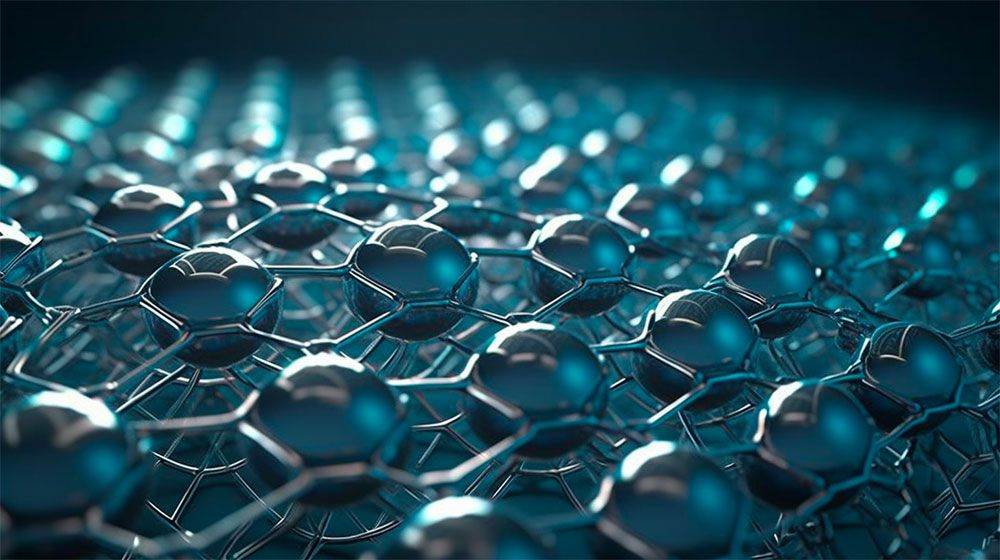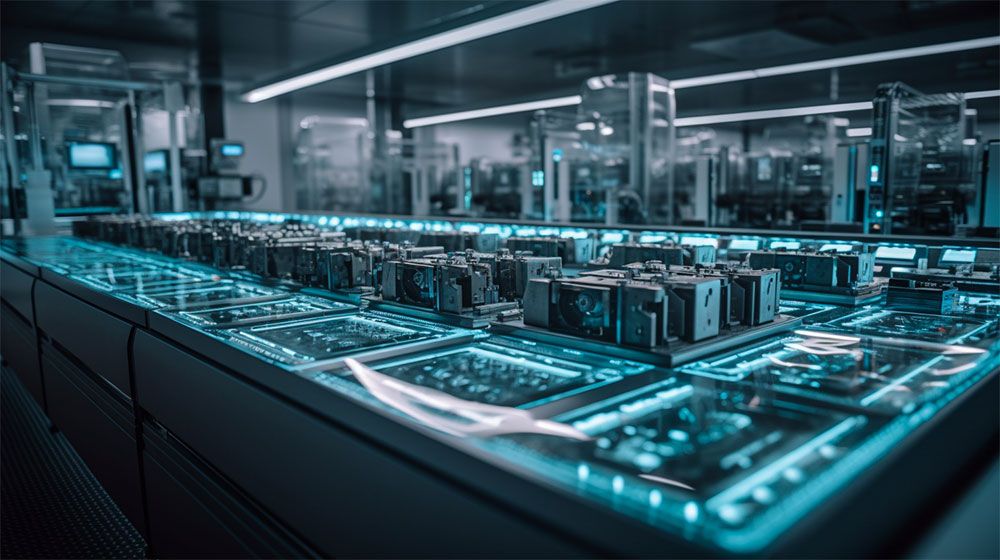The Materials Revolution: How Nanotechnology and AI Will Disrupt Materials Science and Our Lives

The materials we use daily have undergone a revolution in recent years, thanks to advances in nanotechnology and artificial intelligence (AI). From stronger and lighter metals to self-healing materials, the possibilities are endless. Nanotechnology has enabled us to manipulate materials at the nanoscale, while AI is being used to design and optimise new materials with unprecedented speed and accuracy.
Together, these technologies are set to disrupt the field of materials science and transform the products and devices we use every day. In this article, we'll take a closer look at the materials revolution and explore how nanotechnology and AI are reshaping the future of materials science and our lives.
Let's dive in and explore the exciting world of material science!
Definition of the Materials Revolution
The Materials Revolution is a term used to describe the major changes taking place in materials science. This revolution involves developing and using new materials, technologies, and processes to create products with improved performance.
From the Stone Age, Bronze Age, and Iron Age onwards, the progress of materials has enabled humans to push beyond their previous limits and achieve great things.
Today, the Materials Revolution is propelled forward by two major forces: nanotechnology and artificial intelligence.
Nanotechnology is the manipulation of matter on an atomic or molecular scale. It involves using materials up to 100,000 times smaller than the width of human hair, and materials behave fundamentally differently at that scale. This technology can be used to create incredibly strong and lightweight materials, as well as new devices for use in various industries.
For example, nanoparticles of certain materials can have unique optical, electronic, and magnetic properties, making them useful for developing new technologies such as:
- Medical implants
- Smartphone components
- Solar cells
- Sensors
- Advanced batteries
Conversely, AI can be used to automate and optimise the design, production, and testing of new materials. For instance, AI-driven simulations can help researchers identify promising materials and predict their performance in different conditions.
AI also has a range of potential applications outside the materials world, from robotics to autonomous vehicles. The combination of nanotechnology and AI is leading to a revolution in materials science. This new era of materials engineering is opening up immense possibilities for innovation and progress across many industries. An introduction to AI is not necessary, I have written extensively about artificial intelligence, but an introduction to nanotechnology is useful to better understand how it will change materials.
Introduction to Nanotechnology

Nanotechnology is a branch of science that involves manipulating materials at the nanoscale, which is roughly one billionth of a meter. The potential applications of nanotechnology are vast and exciting, particularly in materials science.
Nanotechnology allows scientists to create materials with enhanced properties, such as increased strength and conductivity. Nanotechnology is already being used in a wide range of industries, from electronics to medicine.
Nanotechnology has a wide range of applications in materials science, including:
Creating new materials with unique properties: Nanotechnology can be used to create new materials with properties that are not found in nature. For example, nanoparticles can be used to create stronger, lighter, or more durable materials than traditional materials.
Improving the properties of existing materials: Nanotechnology can also be used to improve the properties of existing materials. For example, nanoparticles can make metals stronger, ceramics more resistant to heat, and plastics more flexible.
Developing new devices and applications: Nanotechnology is also being used to develop new devices and applications. For example, nanoparticles are being used to develop new types of batteries, solar cells, and sensors.
Examples of nanotechnology in creating new materials with unique properties
Gold nanoparticles have been shown to have antibacterial properties. This is because the nanoparticles can bind to and kill bacteria. Bandages, wound dressings, and toothpaste contain gold nanoparticles.
Carbon nanotubes are one of the strongest materials known to man. They are also very lightweight and conductive. Carbon nanotubes are being used in a variety of applications, including electronics, composites, and energy storage.
TiO2 nanoparticles are used in sunscreens because they can absorb ultraviolet radiation. They are also being used in self-cleaning coatings and water purification systems.
Benefits of Nanotechnology
There are many potential benefits to using nanotechnology in materials science. Some of these benefits include:
Improved strength and durability: Nanomaterials possess exceptional mechanical properties such as high strength, stiffness, and toughness, making them ideal for applications where strength and durability are crucial.
Enhanced electrical and thermal properties: Nanomaterials exhibit excellent electrical and thermal conductivity, which makes them suitable for use in electronic and energy storage devices.
Lightweight: Nanomaterials can be extremely lightweight and can have a high surface area-to-volume ratio, making them ideal for applications where weight reduction is critical.
Improved performance: The unique properties of nanomaterials enable the development of materials with enhanced performance, such as increased efficiency, improved sensitivity, and higher selectivity.
Nanotechnology Challenges
The use of nanotechnology in materials science, however, also poses several challenges, such as:
Safety concerns: The potential toxicity of some nanomaterials is a significant concern, and there is a need for proper handling, storage, and disposal of nanomaterials to prevent harm to humans and the environment.
Cost: The development and production of nanomaterials can be expensive, and the high cost may limit their widespread use.
Regulatory challenges: There needs to be more standardised regulations for the production, handling, and use of nanomaterials, which poses challenges for their commercialisation.
Scaling up: The production of nanomaterials at a large scale is still a significant challenge, and there is a need for new manufacturing processes and equipment.
Now that you have a better understanding of nanotechnology, let's turn to the wide variety of alternative fuels and materials that become possible due to the convergence of AI and nanotechnology.
Alternative Fuels and Materials

Alternative fuels are any fuel that does not come from fossilised remains. Fossil fuels are derived from ancient plants and animals buried and compressed over millions of years, such as coal, oil, and natural gas.
Alternative fuels can be categorised as either renewable or non-renewable.
Renewables such as biomass, solar power, and wind energy are quickly replenished. Non-renewables, on the other hand, are not rapidly replenished and include nuclear and geothermal energy.
Benefits of Alternative Fuels
Alternative fuels have gained increasing attention in recent years due to concerns about climate change and the finite supply of fossil fuels. Reducing our reliance on traditional fuels will allow alternative fuels to offer numerous benefits, including improving air quality, reducing dependence on foreign oil, and creating new economic opportunities. In this context, let's take a closer look at some of the key benefits of alternative fuels.
Reduce our reliance on fossil fuels: Alternative fuels such as biofuels, hydrogen fuel cells, and electric power can help reduce our dependence on traditional fossil fuels like oil, coal, and natural gas. This can lead to a more diversified and sustainable energy mix, improving energy security and reducing price volatility.
Protect the environment and combat climate change: Burning fossil fuels releases greenhouse gases into the atmosphere, contributing to climate change. Alternative fuels can help reduce greenhouse gas emissions and mitigate the impacts of climate change. For example, biofuels can be made from crops that absorb carbon dioxide as they grow, which can offset the emissions produced when the fuel is burned. We’ll expand more on this matter later in this article.
Improve air quality: Traditional fuels can also contribute to air pollution, which can have serious health impacts. Alternative fuels burn cleaner than fossil fuels, improving air quality and reducing the risk of respiratory illnesses.
Reduce our dependence on foreign oil: Many countries rely on imported oil to meet their energy needs. Alternative fuels can help reduce this dependence, increasing energy security and reducing geopolitical tensions.
Create new jobs and economic opportunities: The transition to alternative fuels will require new infrastructure, technology, and expertise, which can create jobs and stimulate economic growth. For example, the production of biofuels can create jobs in agriculture, biotechnology, and manufacturing.
How Are Alternative Fuels Changing the Energy Landscape?
The world is slowly but surely moving towards a more sustainable future.
According to the United Nations, the use of fossil fuels in 2018 caused an astounding $2.9 trillion in health and economic costs - that's $8 billion every day.
According to McKinsey's Global Energy Perspective 2022 report, in the long run, sustainable fuels like hydrogen and biofuels will be key players in the energy transition.
Solar, wind, and hydropower are increasingly popular renewable energy sources that look set to keep growing in popularity. Making the switch to clean sources of energy can help to reduce these costs, as well as improve public health. The future of energy is green, and we should all do what we can to support it.
The way forward is clear: renewable energy and alternative fuels are key to a more sustainable future. It is up to us to ensure we play our part in making this happen.
The Role of Materials in the Transition to Alternative Fuels
Materials play an integral role in this transition, as they are used to create new energy systems, fuel storage solutions, and renewable power sources. For example, advanced materials such as carbon composites enable the development of lightweight structures for wind turbines, solar panels, and other renewable energy technologies.
Innovative superconductors are also being developed to improve the efficiency of energy transmission and storage. In addition, advanced batteries and fuel cells are being developed using materials such as lithium-ion and nickel-metal hydride. These technologies will enable us to store renewable energy for later use and move away from our reliance on fossil fuels.
Incorporating Synthetic Biology
Alternative fuels and materials are of great interest due to concerns about climate change and the finite supply of fossil fuels. Synthetic biology is a rapidly developing field that has the potential to revolutionise the production of these alternative fuels and materials.
Synthetic biology, which I covered extensively before, involves designing and constructing biological systems for specific purposes. This can include engineering microbes to produce biofuels or bioplastics or using genetically modified crops for bioenergy production.
Synthetic biology and alternative fuels can be linked by producing biofuels from algae. Algae can be engineered to produce large quantities of lipids, which can be converted into biofuels. Researchers are working on developing strains of algae that can produce even higher lipid yields and optimising the conversion process.
Another demonstration is the use of synthetic biology to produce bioplastics. Bioplastics are made from renewable materials and can be biodegradable, making them a promising alternative to traditional plastics. Scientists are engineering microbes from renewable sources to produce the building blocks for bioplastics, such as polylactic acid (PLA).
Synthetic biology has the potential to play a major role in the development of alternative fuels and materials, which is why I covered it extensively in my fifth book Future Visions. Engineering biological systems to produce these products can help us move towards a more sustainable and environmentally friendly future.
Materials Used in Alternative Fuel Technology

Here are some examples of materials used in alternative fuel technology:
Graphene
Graphene is a material made of pure carbon arranged in a single, transparent sheet that's only one atom thick. It is extremely strong but very lightweight - in fact, it is 100 times stronger than steel. Graphene is also great at conducting heat and electricity. Although it is black, like graphite, it is nearly transparent because of how thin it is.
Recently, scientists discovered that graphene has a new property called ferroelectricity, which could make information processing even faster.
Graphene, with its extraordinary mechanical, electrical, and thermal properties, holds potential for a vast range of applications.
Here are some of the most promising applications of graphene in various industries:
Electronics: Graphene has the potential to revolutionise the electronics industry due to its superior electrical conductivity and flexibility. It can be used to create high-speed transistors, flexible touchscreens, and ultrafast computer chips.
Graphene-based batteries have also been developed to charge faster and last longer than traditional batteries. A great example is Samsung, which uses nanotechnology in its electronic devices to create more efficient and powerful microprocessors and memory devices. Samsung has developed a 10-nanometer FinFET technology for faster and more energy-efficient processing.
Medicine: Graphene has shown potential in various medical applications due to its biocompatibility and unique properties. For instance, it can be used to create biosensors that detect diseases or for drug delivery systems that target specific cells. Graphene can also be used to create artificial joints that are stronger and more durable than traditional joints. Novartis is using nanotechnology to develop new drug delivery systems. This technology allows for the creation of more soluble drugs and, therefore, more effective.
Aerospace: Graphene's lightweight and strength make it a promising material for the aerospace industry. It can be used to create strong and lightweight composites that can be used to make planes and spacecraft more fuel-efficient. Also, graphene-based sensors can be used to detect changes in temperature, pressure, and other conditions in spacecraft. NASA has developed a nanomaterial called aerogel, which is 95% air and is the lightest solid material in the world
Green Carbon Materials

Green Carbon Materials (GCMs) are carbon-based materials derived from renewable sources or produced through sustainable processes. They are often called "green" due to their lower environmental impact than traditional carbon materials made from fossil fuels.
GCMs can be formed from biomass, agricultural waste, and even carbon dioxide, and their production processes include hydrothermal carbonisation (HTC), pyrolysis, and chemical vapour deposition (CVD).
GCMs can be used in a wide variety of sustainable products, including:
Sustainable Packaging Materials
Instead of using traditional plastic packaging, which is derived from non-renewable resources and takes hundreds of years to degrade, companies can use green carbon materials such as bioplastics, which are derived from renewable resources and biodegradable.
Construction Industry: Bamboo and hempcrete are two sustainable building materials made from green carbon materials. These materials are strong, durable, and have a low carbon footprint, making them an ideal choice for sustainable construction projects.
Bio-leather: Compared to traditional synthetic leather, bio-leather has a significantly lower carbon footprint, with some sources claiming a reduction of up to 97%. Furthermore, bio-based synthetic materials create fully recyclable shoes, reducing waste and promoting a circular economy.
Sustainable Textiles: Fabrics made from bamboo and other sustainable plant fibres are becoming increasingly popular due to their low environmental impact and biodegradability. The use of green carbon materials is crucial for environmentally conscious individuals and businesses who hope to minimise their impact on the planet.
Despite the many advantages of using green carbon materials, several challenges must be addressed before they can become widely used as replacements for traditional materials.
Challenges of Green Carbon Materials
As the demand for sustainable materials continues to grow, addressing the issues related to the production, cost, and performance of green carbon materials is becoming increasingly important. Understanding the challenges facing these materials allows us to appreciate the innovative solutions being developed by researchers and industry leaders to achieve a more sustainable future.
Let's look at the main challenges of green carbon materials and how they are addressed.
Sourcing of Raw Materials: Green carbon materials are derived from renewable resources such as biomass and organic waste. As demand for these materials increases, there is a risk of over-exploitation of natural resources, leading to environmental degradation.
Therefore, it is important to establish sustainable sourcing practices that ensure the long-term availability of raw materials.
High-Cost: Green carbon materials are often more expensive to produce than traditional materials derived from non-renewable resources. This can be a major barrier to adoption, particularly for small businesses and startups.
Therefore, finding ways to reduce the cost of production is crucial for the widespread adoption of green carbon materials.
Processing Technology: The processing technology required to manufacture green carbon materials is often more complex than traditional materials. This can increase the complexity and cost of production and can also require specialised equipment and expertise.
Standardisation: A lack of standardisation in the production and use of green carbon materials can create uncertainty for manufacturers and consumers alike. Establishing clear standards and regulations for producing and using these materials can help build confidence in their sustainability and safety.
Supply Chain Logistics: Green carbon materials are often produced on a small scale, which can create challenges in terms of logistics and distribution. This can make it difficult to scale up production and ensure a consistent supply of materials.
Metallic Foam

Metallic foam, a unique material or structure of solid metal and gas-filled pores, has gained attention recently due to its remarkable properties.
These pores can either be sealed or interconnected, creating two types of metal foam: closed-cell foam and open-cell foam. What sets this material apart from others is its high porosity, with only a small percentage of the volume being actual metal. Despite this porosity, metallic foam is incredibly strong thanks to the square-cube law.
In short, the potential uses for this innovative material are expansive and exciting. As technology advances, it is exciting to contemplate the possibilities of metallic foam in revolutionising various industries thanks to its unique properties.
Unique Properties of Metal Foams
Lightweight: Metal foams are much lighter than solid metal, with densities as low as 1/5 of that of solid metal. This makes them ideal for applications where weight is a critical factor, such as aerospace and automotive engineering.
High strength: Metal foams can be surprisingly strong, with compressive strengths comparable to or even higher than those of solid metal. This is due to the fact that the pores in the foam act as stress risers, which distribute the load more evenly throughout the material.
High energy absorption: Metal foams are very good at absorbing energy, making them ideal for applications where impact resistance is important, such as body armour and crash barriers.
Good thermal insulation: Metal foams have a low thermal conductivity, which makes them good insulators. This makes them ideal for applications where heat dissipation is important, such as thermal insulation and fire protection.
Good sound absorption: Metal foams are good at absorbing sound, making them ideal for applications where noise reduction is important, such as acoustic panels and soundproofing.
Metal foams have a wide range of potential applications in a variety of industries, including:
- Aerospace: Aircraft structures, engine components, and landing gear.
- Automotive: Brake pads, exhaust systems, and fuel tanks.
- Construction: Soundproofing, thermal insulation, and fire protection.
- Electronics: Heat sinks, EMI shielding, and antennas.
- Medical: Bone implants, tissue engineering, and drug delivery.
Challenges of Metallic Foam
Manufacturing: The manufacturing of metal foams is a challenging process. The pores in the foam must be uniform in size and shape and evenly distributed throughout the material. This is a difficult task, and it is one of the main challenges in the research and development of metal foams.
Cost: Metal foams are currently more expensive than solid metal. This is due to the manufacturing process, which is more complex and time-consuming. As the technology for manufacturing metal foams improves, the cost of this material is expected to decrease.
Performance: Metal foams are not as strong as solid metal in all applications. This is because the pores in the foam can act as stress risers, which can lead to premature failure. Researchers are working on developing new materials and manufacturing techniques to improve the performance of metal foams.
Materials Revolution and Climate Change
The materials revolution is the development of new materials with improved properties, such as strength, lightness, durability, and sustainability. These new materials have the potential to play a major role in fighting climate change by reducing our reliance on fossil fuels and making our infrastructure more resilient to extreme weather events.
Some examples of materials used in climate change mitigation efforts include:
Carbon fibre is a lightweight, strong material often used in constructing cars, aeroplanes, and wind turbines. It is also being used to develop new types of solar panels and batteries. Lighter aeroplanes require less fuel, which can also be alternative fuel.
Graphene, since it is a thin layer of carbon atoms, can be incredibly strong and conductive. It is being used to develop new types of batteries, solar cells, and sensors.
Biomaterials are materials that are derived from living organisms. They are being used to develop new types of medical implants, wound dressings, and food packaging.
The materials revolution can play a significant role in fighting climate change. By developing new materials, we can reduce our dependency on fossil fuels, improve energy efficiency, and reduce carbon dioxide emissions.
Implications for Businesses and Consumers

Nanotechnology and the material revolution are rapidly changing how businesses operate, and consumers interact with products. These technologies have the potential to revolutionise manufacturing, improve product performance, and create entirely new markets. Here are some unique and revealing insights into the impact of nanotechnology and the material revolution on businesses and consumers:
Enhanced Product Performance
It is possible to create materials with enhanced performance characteristics that were previously not possible. As an example, using carbon nanotubes in electronics has greatly improved the electrical conductivity of these devices, leading to faster and more efficient performance. In addition, using nanomaterials to construct lightweight and strong materials has led to the creation of new products that are more durable and resistant to damage.
Nanotechnology and advanced materials are also used to develop products with enhanced thermal properties. For instance, the use of nanomaterials in the production of insulation materials has greatly improved their ability to regulate temperature, reducing the energy needed for heating and cooling.
Improved Manufacturing Processes
Another major advantage of nanotechnology and advanced materials is the potential to improve manufacturing processes greatly. With these technologies, it is possible to create products with more precise and uniform properties and manufacture products with less waste and energy consumption.
Among them, the use of nanomaterials in 3D printing has greatly improved the precision and quality of printed products, reducing the need for post-processing and waste. Also, the development of self-assembling materials that can arrange themselves into specific patterns and structures has the potential to greatly simplify and speed up manufacturing processes, reducing the need for complex and costly assembly processes.
Nanotechnology and advanced materials are also being used to develop more durable and reliable products that require less maintenance and repair. For example, the use of graphene in the production of automotive components has led to the creation of lighter and stronger parts that are more resistant to wear and tear, reducing the need for frequent replacements and repairs.
Environmental Benefits
Nanotechnology and advanced materials also offer significant environmental benefits. One of the primary advantages is the ability to create more sustainable products and processes that reduce the environmental impact of manufacturing and industry.
For example, the use of nanocatalysts in chemical reactions can greatly reduce the amount of energy required for chemical synthesis, reducing greenhouse gas emissions and energy consumption. Developing biodegradable materials made from renewable resources can greatly reduce waste and pollution while conserving non-renewable resources.
Nanotechnology and advanced materials are also used to create more efficient and sustainable energy production and storage systems. Using nanomaterials in solar panels has greatly improved their efficiency, making them a more viable and sustainable renewable energy source.
Similarly, the use of nanomaterials in energy storage systems has the potential to greatly increase their capacity and durability, reducing the need for frequent replacements and reducing waste.
New Market Opportunities
Nanotechnology and advanced materials are revolutionising how we manufacture and design products, creating entirely new markets that were previously unimaginable. The ability to manipulate materials at the nanoscale has opened up new possibilities for creating materials with unique properties and functionalities. In contrast, advancements in advanced materials have made it possible to develop stronger, lighter, and more durable products.
The wearable technology industry is a new market created by nanotechnology and advanced materials. With the development of flexible and lightweight materials such as graphene and nanotubes, it is now possible to create wearable devices that can be seamlessly integrated into clothing or accessories. These devices can monitor health metrics, provide haptic feedback, and generate energy from body movements, opening up new possibilities for health and wellness applications.
As a matter of fact, Nanowear Inc. is an exciting company that is at the forefront of the development of wearable sensing technology for healthcare applications, and its products have the potential to improve patient outcomes and transform the delivery of healthcare services. The company has developed a range of patented nanotechnology-based sensors and smart fabrics that can monitor vital signs and other physiological parameters in real-time, including heart rate, respiratory rate, and body position.
Nanowear's products are designed to provide clinicians with continuous, accurate, and reliable patient data, which can help to improve the management of chronic conditions such as heart failure, diabetes, and chronic obstructive pulmonary disease (COPD). The company's flagship product, SimpleSense, is a remote monitoring system worn under clothing and transmits data wirelessly to a secure cloud platform, where healthcare providers can access it.
Then, we can also highlight the field of energy storage as a new market created by nanotechnology and advanced materials. With the development of nanomaterials such as carbon nanotubes and graphene, it is now possible to create high-capacity batteries that are both lightweight and durable. These batteries can be used in a wide range of applications, from powering electric vehicles to storing energy from renewable sources such as solar and wind.
In addition, the field of construction is also experiencing a revolution thanks to nanotechnology and advanced materials. For instance, using nanoclay to produce building materials has led to the creation of stronger and more durable construction products. The development of self-healing materials that can repair cracks and other damage has the potential to greatly reduce the need for maintenance and repair in the construction industry.
The implications for businesses and consumers are also significant in terms of sustainability. Businesses that adopt sustainable materials and practices can reduce their environmental impact and save money. Consumers can also help to fight climate change by choosing sustainable products and services.
Businesses can use sustainable materials in their products and operations. For example, a furniture company could use bamboo instead of wood, or a car company could use recycled materials in its cars.
Businesses can also reduce their energy consumption by using energy-efficient materials, such as insulation and windows. Consumers can choose sustainable products and services. For example, a consumer could buy a bamboo toothbrush instead of a plastic toothbrush or a car with a hybrid engine. Consumers can also reduce their energy consumption by using energy-efficient appliances and light bulbs.
As these technologies advance, we can expect to see even more innovative products and applications emerge, further transforming how we live and work.
Embracing the Materials Revolution: What Business Leaders Need to Do

The materials revolution brought about by nanotechnology and AI will have a profound impact on various industries. Business leaders must be aware of these changes to remain competitive in their respective fields. Here are some ways that business leaders can embrace the materials revolution:
Businesses need to invest in research and development to explore the potential applications of nanotechnology and AI in their industry. This could involve partnering with universities or research institutions to develop new materials or collaborating with startups that are at the forefront of this technology. Companies that fail to invest in research and development risk being left behind by their competitors who have embraced the materials revolution.
With that said, collaboration is key to success in the materials revolution. Business leaders should seek partnerships and collaborations with industry experts, including materials scientists, engineers, and AI specialists. They can combine their knowledge and expertise to develop new products and solutions optimised for the latest materials and manufacturing processes. Collaboration can also help companies to reduce costs and improve efficiency.
Sustainability is an essential consideration in the materials revolution. Business leaders should prioritise the development of eco-friendly materials and manufacturing processes that minimise waste and reduce environmental impact. This approach not only benefits the environment but can also help companies to build a positive reputation and attract customers who value sustainability.
Adapting to changing market demands is critical in the materials revolution. As new materials and products enter the market, business leaders must be prepared to adapt to changing consumer preferences and market demands. This could involve developing new marketing strategies, rethinking supply chain logistics, or pivoting towards new products or services that take advantage of the latest materials.
To fully embrace the materials revolution, businesses must build a culture of innovation that encourages experimentation, risk-taking, and creative problem-solving. This could involve investing in employee training and development or creating a startup-like environment that fosters innovation and collaboration. As a result of developing a culture of innovation, businesses can create a competitive advantage that drives growth and innovation in their respective industries.
Final Thoughts
The materials revolution has a huge potential to play a major role in fighting climate change by reducing our reliance on fossil fuels and removing carbon dioxide from the atmosphere. Sustainable materials are key in helping to reduce energy consumption and create products with improved properties.
Businesses and consumers can take advantage of this opportunity by being aware of their environmental impact and choosing products and services accordingly.
If we all work together, the materials revolution can have a lasting positive effect on our planet. After all, every bit counts regarding protecting our environment – and we have no time to lose!
Images: Midjourney





